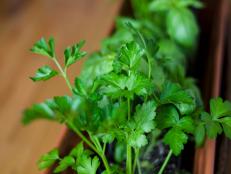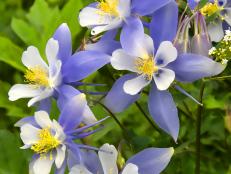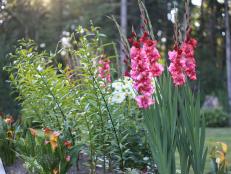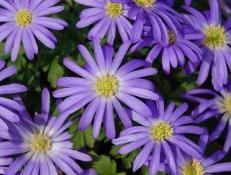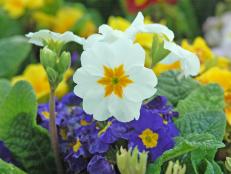How to Grow Saffron Flower
Saffron is the world’s most expensive spice, but it’s also one you can easily grow yourself. Learn what you need to know about growing saffron.
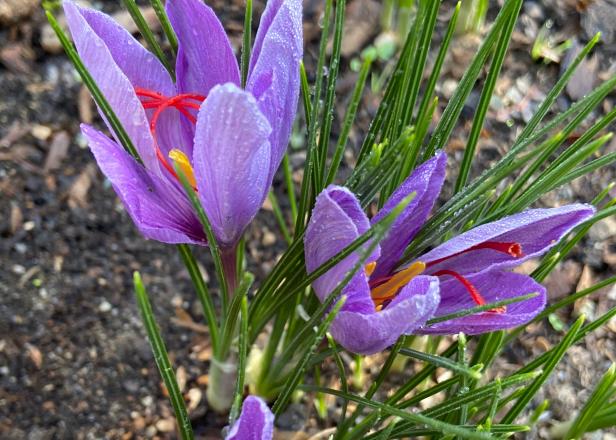
ReneesGarden.com
Saffron crocus (Crocus sativus) flowers in autumn, looking very much like spring-flowering crocus. The spice saffron is the dried, bright red stamens inside the flower. Hardy in Zones 5-8.
Delicious and colorful, saffron is a spice beloved the world over. Its unique flavor is the secret ingredient that makes dishes like Spanish paella, Indian curry and Swedish saffron buns sing. This spice comes from the saffron flower, which is a type of crocus.
Botanically known as Crocus sativus, saffron crocus blooms in the fall, with each purple saffron flower opening to reveal long red threads that, when dried, are the saffron spice we know and buy.
Botanical name: Crocus sativus
Common Name: Saffron crocus
Days to Harvest: 90 to 100 days after planting
Special features: Flowers appear in fall
Plant Type: Perennial
Size: Grows 6 to 12 inches tall and 2 to 4 inches wide
Hardiness: Zones 5 to 8
The threads inside a saffron flower are botanically known as the stigma. Each flower yields three stigmas — or saffron threads. Each saffron crocus bulb produces up to four flowers, but that's only with age (the oldest bulbs). It takes many blossoms to yield even a small amount of this prized and expensive spice.

ReneesGarden.com
It’s amazingly simple to grow your own saffron. When the crocus flowers open, remove the bright red threads, let them air dry, and you’re ready to savor the flavor of saffron.
If you love saffron, the great news is that saffron flowers are easy to grow for your own use. The hardest part about growing saffron is harvesting it. Learn what you need to know to grow saffron crocus.
How to Grow Saffron Crocus
Saffron Crocus Bulbs
Like spring crocuses, saffron flowers grow from corms, which, botanically speaking, aren't the same thing as bulbs, although most people lump them together because they're pretty similar. That's why you'll often see saffron crocus bulbs for sale instead of saffron corms.
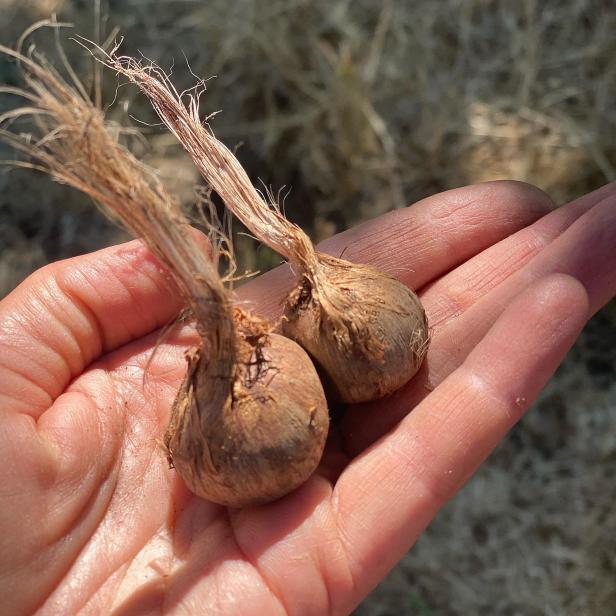
Peace & Plenty Farm at PeacePlentyFarm.com
Saffron comes from the flower of Crocus sativus, also known as saffron crocus. Like spring crocus, this spice-yielding bloomer grows from a corm, a bulb-like structure.
Look for saffron crocus bulbs for sale from bulb companies — seed companies that also sell bulbs — like Renee's Garden, or farmers who raise saffron, like Peace and Plenty Farm. Some traditional farmers are growing saffron as a cash crop. Research online to find farmers near you who might have corms for sale. Like other flower bulbs, you want to buy the largest saffron bulbs you can because bigger bulbs produce more flowers.
How many saffron bulbs do you need to grow saffron as a crop? Roughly 50 to 60 saffron flowers yield about 1 tablespoon of dried saffron. Most family-size dishes call for a generous pinch of saffron. So, 24 medium-to-large saffron bulbs should give you enough saffron in the first year to savor a few dishes where the spice flavor sparkles.
Avid saffron fans who use the spice frequently in their cooking report growing 150 to 200 bulbs. The bulbs multiply over time, so starting small will yield big results — in time. The bulbs also get larger over time, producing more flowers.
Planting
Plant your saffron bulbs as soon as possible after receiving them. Leaf growth typically occurs from early spring until hot summer weather triggers dormancy. In mild regions like California, leaf growth can occur from September through mid-May, when heat induces dormancy.
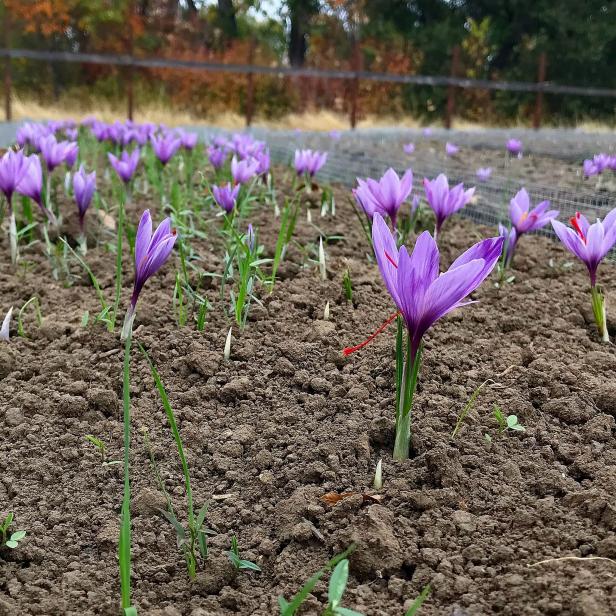
Peace & Plenty Farm at PeacePlentyFarm.com
Saffron comes from the flower of saffron crocus (Crocus sativus). It looks similar to the crocus blooms that herald spring’s arrival, except it blossoms in the fall.
During dormancy, leaves die back and the saffron bulbs rest. Mark your saffron planting area well, because when the bulbs are dormant, there's no clue anything is planted in that spot. In fall the bulbs awaken, and flowers appear, along with a second crop of leaves.
Grow saffron crocuses in a sunny spot. Plants should receive at least six hours of sun each day — more for plants in more northerly regions. The ideal soil for growing saffron should be nutrient-rich and well-drained. Choose a spot that stays relatively dry in summer during saffron bulbs' dormant time.

Lupine Hammack for Peace & Plenty Farm at PeacePlentyFarm.com
Bees can’t resist saffron blooms and buzz among harvested flowers in baskets and even in hands that are working to remove the saffron threads.
Rodents like gophers, moles and mice love to munch saffron bulbs. If you have a problem with these critters in your growing region, prepare the planting bed by lining it with hardware cloth. The other option is to grow your saffron crocuses in containers.
In beds, plant saffron bulbs 4 to 8 inches deep and 6 to 8 inches apart. In regions where hard freezes occur, plant saffron bulbs deeper to provide a little extra protection. For saffron crocuses in containers, plant corms 2 inches deep and 2 inches apart.
Water & Fertilizer
Saffron crocuses don't need tons of water to thrive. During the active growing period when leaves and/or flowers are present, keep soil just slightly moist. When saffron bulbs are dormant, do not water at all.
Too much water, especially during dormancy, will rot the saffron crocus bulbs. In regions with wet summers, growing saffron crocuses in containers is a great idea because you can move the pots into a dry area during the dormant period.
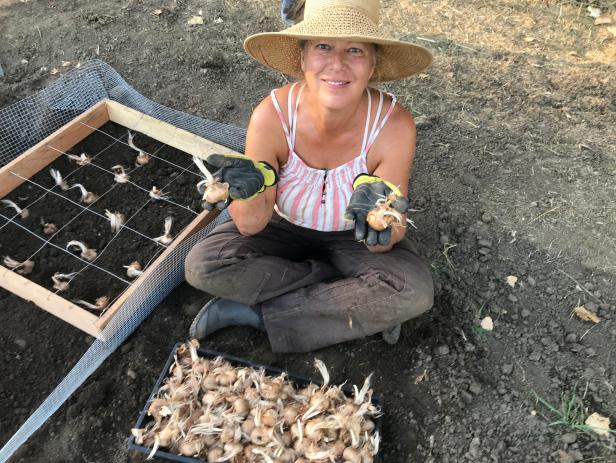
Peace & Plenty Farm at PeacePlentyFarm.com
Melinda Price runs Peace & Plenty Farm with her husband, Simon Avery. The organic farm raises lush crops of saffron, selling both the spice and the corms. Melinda uses a grid frame to help her space saffron corms accurately. Hardware cloth lines the beds to deter gophers.
To fertilize saffron crocus, work organic fertilizer into soil prior to planting at the rate suggested on the product label. Or you can use a traditional nitrogen-based fertilizer, applying it as a top dressing after planting.
Dividing Bulbs
When you're growing saffron, over time the bulbs multiply, with new corms forming on top of the old. As this occurs, saffron flower bulbs "migrate" upward in soil as the daughter corms keep forming around and on top of the mother. Because of this, you'll need to dig and divide your saffron bulbs every two to five years. If you wait too long to divide corms, flower production will drop off. That's a clue it's time to divide.
Tackle this task in summer, the plant's dormant season. Separate daughter corms from the mother, saving the biggest ones for replanting. Share the wealth with friends and family who love saffron and coach them on growing their own crop.
Growing Saffron Crocus in Containers
It's possible to grow saffron flowers in containers. You might choose this method if your region has wet summers, heavy rodent populations or if saffron isn't hardy in your growing zone. Use a pot with drainage holes. In pots, plant saffron bulbs 2 inches deep and 2 inches apart.
In regions where saffron bulbs aren't winter hardy, store pots over winter in a cool, unheated location, like a garage or root cellar — somewhere the soil won't freeze. Water every six weeks and move containers outdoors in spring.
How to Harvest Saffron
Saffron harvesting is probably the most difficult part of growing saffron. Ideally, pick flowers just before or immediately after they open. This means early morning is the right time for saffron harvesting, before the sun coaxes blooms to open. Snip or pinch the blossom stem and place it in a basket. Use care not to crush the delicate blooms.
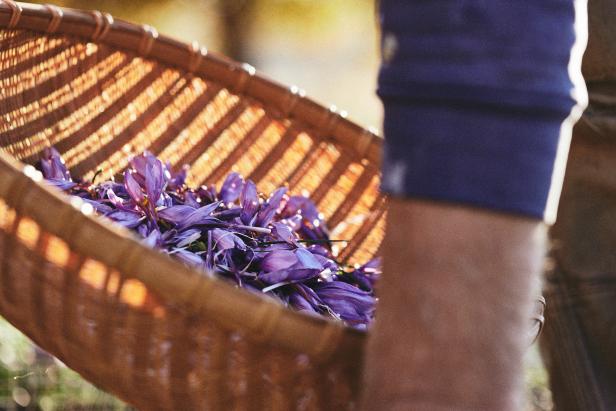
Lupine Hammack for Peace & Plenty Farm at PeacePlentyFarm.com
Saffron blooms in autumn, and harvest at Peace & Plenty Farm starts at daybreak, when temperatures dip as low as 22°F. Newly opened and just-about-to-open flowers are gathered into baskets.
Inside the blossoms are three long, blood-red stigmas or threads. Pluck these using your fingers or tweezers from each flower. The stigmas will stain your fingers gold. The highest quality saffron has not been pollinated, which is why you want to gather flowers before they open and bees spread pollen to the stigmas.

Lupine Hammack for Peace & Plenty Farm at PeacePlentyFarm.com
Saffron is the long red thread (botanically it’s called a “stigma”) inside the Crocus sativus bloom. The reason why saffron is so expensive is because the only way to extract the saffron is by hand, a laborious process.
Drying and Storing Saffron
Dry saffron threads in a warm spot by placing the plucked threads onto a sheet tray, paper plates or paper towels. The goal is for the threads to be completely dry and brittle. This process can take anywhere from overnight to a day or two. In places like Iran, families dry saffron using a fire or electric heaters. Mimic this by drying threads for 20 minutes in a very low oven (150 degrees).
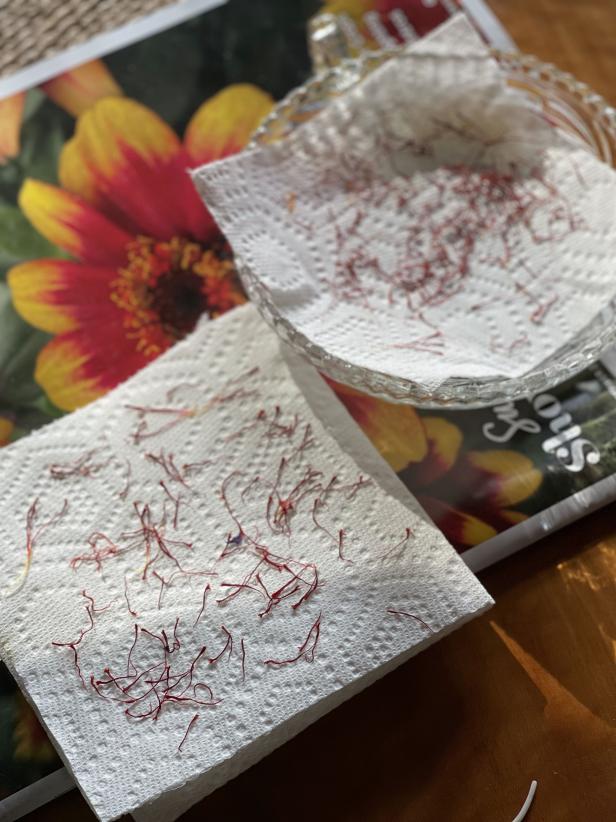
ReneesGarden.com
For home gardeners, the simplest way to dry saffron stigmas is on a paper towel overnight. Threads should be dry to the touch before storing in an airtight container in a dark, cool cupboard.
When threads are dry, transfer them to an airtight container and store it in a dark cupboard for at least two months to allow the saffron flavor to develop fully. When stored in an airtight container, saffron remains fresh for up to two years.
Growing Saffron Crocus FAQs
Where does saffron spice come from?
Iran leads the way in growing saffron, followed by Spain and then other places in Southeast Asia and the Mediterranean.
Why is saffron so expensive?
Saffron sells for upwards of $300 per ounce. Saffron must be hand-harvested — the process defies mechanization. Saffron flowers are hand-picked and then the threads are removed from each blossom by hand. Saffron has been used for about 3,500 years and the saffron harvesting process hasn't changed in all that time. So, harvest labor accounts for much of the high price for this spice.
Is it possible to grow saffron indoors?
Yes, you can force saffron bulbs to bloom much like narcissus or tulip bulbs. Pot the saffron bulbs in fall, keeping them in a cool room until flowers appear.
How should I store saffron?
Saffron is light sensitive, so it's best to store it in a dark cupboard. You can use a brown glass jar or wrap the threads in foil to exclude all light.
If I have heavy clay soil that doesn't drain well, can I grow saffron?
You'll need to amend the soil with plenty of organic matter to improve drainage, or you can skip the hard labor and simply grow saffron crocuses in pots. Many saffron farmers get higher yields from corms grown in containers.
Can I grow saffron seeds?
The saffron crocus is what's known as a sterile triploid. That's botanical-speak for the pollen grains in saffron flowers are sterile, which means the blooms can't produce seeds.

.-Battle-on-the-Beach-courtesy-of-HGTV.-.jpg.rend.hgtvcom.196.196.suffix/1714761529029.jpeg)





